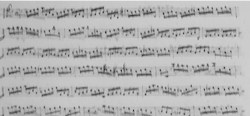This is another follow-up on my essays The Leaping Romanesca (The Pachelbel Pattern): The Basics), The Leaping Romanesca: Two-Part Embellishment (Part 1) and The Leaping Romanesca: Two-Part Embellishment (Part 2). In this essay, I show how one can realize musically interesting realizations of this schema set in three parts. Again, my elaborations are grounded in German and Italian 18th-century repertoire and pedagogical sources.
The Leaping Romanesca is in essence a three-part schema allowing, besides different harmonic settings, a wide range of embellishments in one or more parts. Being an 18th-century credo, these techniques are never a goal in themselves but are intended to reinforce eloquence and persuasion.
In this essay, I will show first how one can embellish one or both upper voices of the Leaping Romanesca. Secondly, I will illustrate how to embellish its bass. Hereafter, some versions with embellishments both in the upper voice(s) and the bass will be shown. Finally, I will give a clever 18th-century alternative harmonization of the Leaping Romanesca. Note that exhaustiveness is not the goal in this essay.
Recap: The Schematic Leaping Romanesca in Three Parts
The examples below show four schematic forms of the three-part Leaping Romanesca (see also my essay The Leaping Romanesca (The Pachelbel Pattern): The Basics):
- Set with only consonances and the upper voice starting on ➌
- Set with only consonances and the upper voice starting on ➊
- Set with the suspension chain starting on ➊ in the middle voice
- Set with the suspension chain starting on ➊ in the upper voice
Note that I have included suggestions for harmonically alternative settings. (See also my essay The Leaping Romanesca: Two-Part Embellishment (Part 2). In the audio files I play the regular versions.) You can apply these alternative settings to the embellishments in this essay.


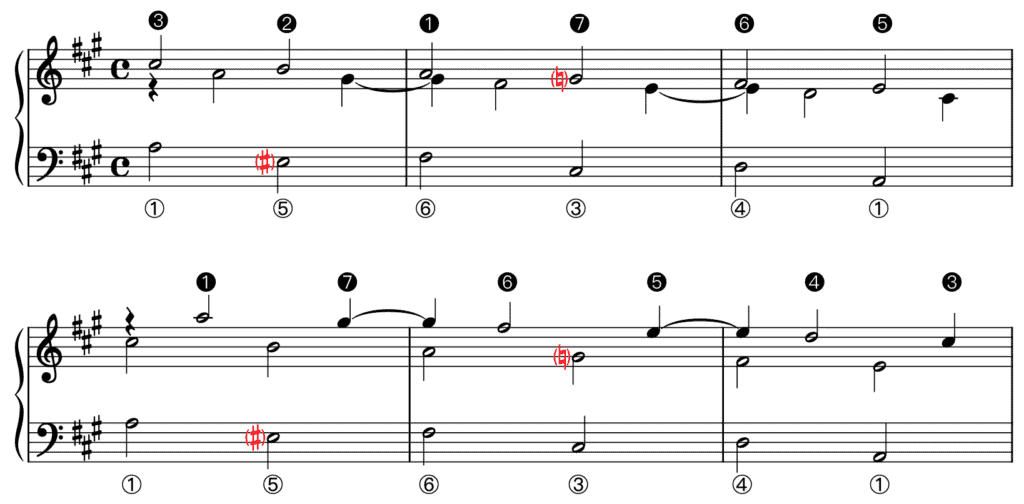
Embellishing One or Both Upper Voices
One of many ways of embellishing the skeletal half notes in an upper voice of the Leaping Romanesca set with only consonances is by transforming them into upper-neighbour-note motives:

(Note that I am not writing out the examples in full so that you can internalize the embellished patterns.)
In the example below, the inner voice is embellished, transforming its skeletal notes into motives consisting of two short notes followed by a long note that is twice as long as each short note:

The following example is basically the same, yet with swapped upper voices:

Both upper voices can also produce the same embellishments simultaneously:

As I explain in my essays The Leaping Romanesca: Two Part Embellishment (Part 1) and The Leaping Romanesca: Two-Part Embellishment (Part 2), repeating the skeletal notes is a straightforward yet effective way of embellishing. The next example illustrates this technique in the context of a setting of this schema with two suspension chains:

When applying that technique to a three-part setting of the Leaping Romanesca including only one suspension chain (starting on ➊), a texture with rhythmically complementary upper voices emerges:
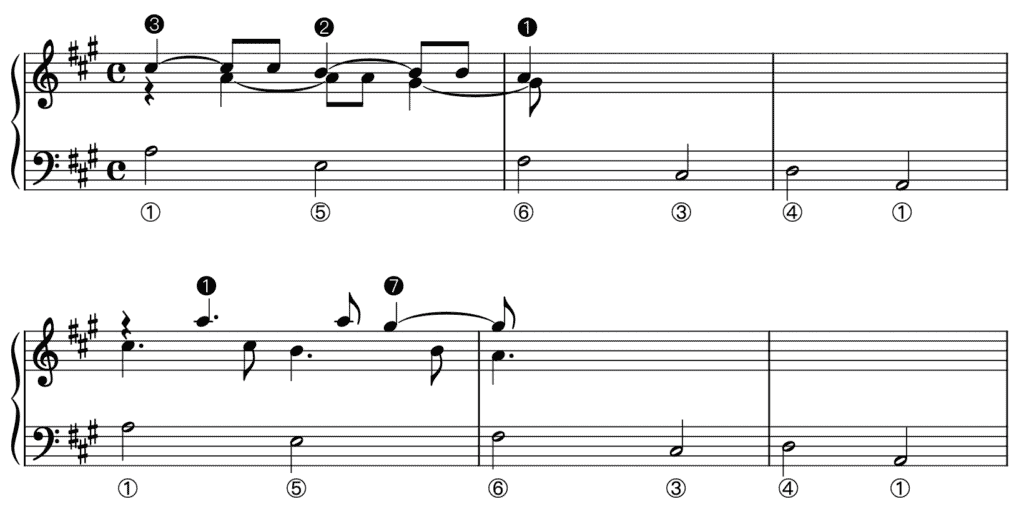
The following example shows a popular 18th-century way of embellishing both upper voices of the Leaping Romanesca, one of which is the suspension chain starting on ➊. In this setting, each skeletal note in both upper voices is embellished by a neighbour-note motive with its shorter note values being sixteenths. As such, an energetic complementary rhythm between the upper voices emerges.

Note the E♯ in the middle voice above ⑥. The reason for this is that, when embellishing a triad, one tends to think of that triad mostly as momentarily establishing a new key, its bass note being ① in that key. As such, the neighbour note in between both F♯s functions as the leading note in F♯ minor. (See also my essay The Leaping Romanesca: Two-Part Embellishment (Part 2).)
Embellishing the Bass
Until now, we have focussed on embellishing the upper voices. However, 18th-century composers wrote versions of the Leaping Romanesca with an embellished bass as well. The most straightforward technique for this is by using repeated notes. In the following example, chordal/consonant skips are used for this purpose.

Note that the even stages in this version are approached by an ascending fifth instead of by a descending fourth. In other words, the note at the onset of the even stages is an octave higher than that in the schematic version. Still, the skeletal note of the even stages does occur as second quarter note reached via a descending octave.
The version above is used, amongst others, by Giacomo Insanguine (1728–1795):

(Insanguine was the last primo maestro of the Conservatorio di Sant’Onofrio a Capuana before that conservatory was merged, two years after his death, with the Conservatorio di Santa Maria di Loreto.)
Note that the second note of the uneven stages in the example of Insanguine is further embellished by a consonant skip back to the skeletal note.
The next version transforms the version with consonant leaps into a version with running eighth notes. To this end, 18th-century maestri usually add two passing notes in between the chordal notes of the uneven stages. As for the even stages in this version, they often open with a descending octave followed by a rising and a descending third back to the skeletal note.

Francesco Durante (1684–1755) and Stanislao Mattei (1750–1825), to name just two, open partimenti with this very version of the Leaping-Romanesca bass:


(Durante was the maestro of Fedele Fenaroli (1730–1818). Stanislao Mattei —not to be confounded with librettist and author on music Saverio Mattei (1742–1795)— was an excellent student of maestro padre Giovanni Battista Martini (1706–1784)).
The version with a bass in eighth notes, in turn, can be transformed into a version with running sixteenth notes by using neighbour notes, passing notes and scales, for instance:

Note that I have put a sharp between parentheses before the eighth sixteenth note, the versions with and without it being equally good. Note also the E♯ in the bass during stage 3 (see my explanation above as well as my essay The Leaping Romanesca: Two-Part Embellishment (Part 2)).
Fenaroli proposes another version of running sixteenths in the bass:

Embellishing the Bass and One or Both Upper Voices
In the following examples, the embellishments that the bass presents during the uneven stages are freely adopted by one or both upper voices during the even stages.




Bariolage
In the context of a Leaping Romanesca, an often used technique on the keyboard to embellish the right hand is the bariolage technique. (I also mention this technique in my essay The Leaping Romanesca (The Pachelbel Pattern): The Basics.) This technique reduces two actual parts into one written part while preserving the perception of the two voices by quickly alternating a note of one voice with a note of the other voice. Below you find the beginning of an intavolatura (keyboard realization) from 1809 of the partimento in A major by Fedele Fenaroli (1730–1818). Compare this realization with the schematic version of the Leaping Romanesca with the suspension chain starting on ➊ in the top voice.
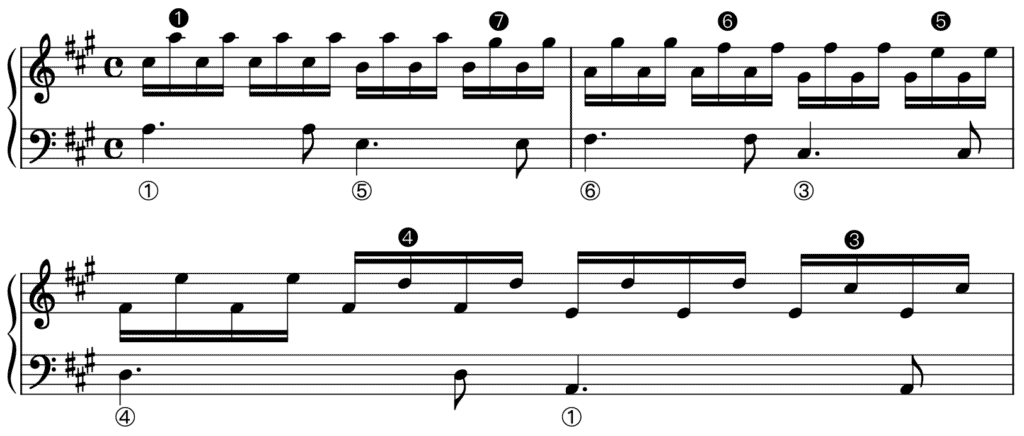
Note that the left hand presents an embellished version of the Leaping Romanesca bass, albeit a rudimentary one with repeated notes, merely changing the skeletal notes into dotted rhythms.
(This intavolatura is part of a manuscript with the title Imitazione del Terzo Libro dèi Partimenti del Sig.r D: Fedele Fenaroli. This manuscript contains 24 so-called intavolature (fully written-out keyboard realizations) of the 49 partimenti from Fenaroli’s third book. I have made a modern edition of this important manuscript, which I have called The Parma Manuscript after the library where it is kept. It can be purchased via www.wessmans.com. At its current state of research, The Parma Manuscript is not only the earliest source with realizations of Fenaroli’s third book but also the only one from Fenaroli’s lifetime.)
For more information on the bariolage technique, see my YouTube video:
(Bariolage is also often used to embellish the right of a moto that descends a third and rises a second.)
Consider now the following example, which is the beginning of a partimento diminuito by Durante.
This partimento is in A major as well, and Durante’s second model for realization is identical to the setting of The Parma Manuscript. (The first model uses bariolage as well yet embellishes the Leaping Romanesca only with consonances.) As for the bass, it is also embellished, and more extensively than is the case in Fenaroli’s partimento. One could argue that in this case the adjective diminuito not only applies to the embellished right hand but also to the embellished bass.
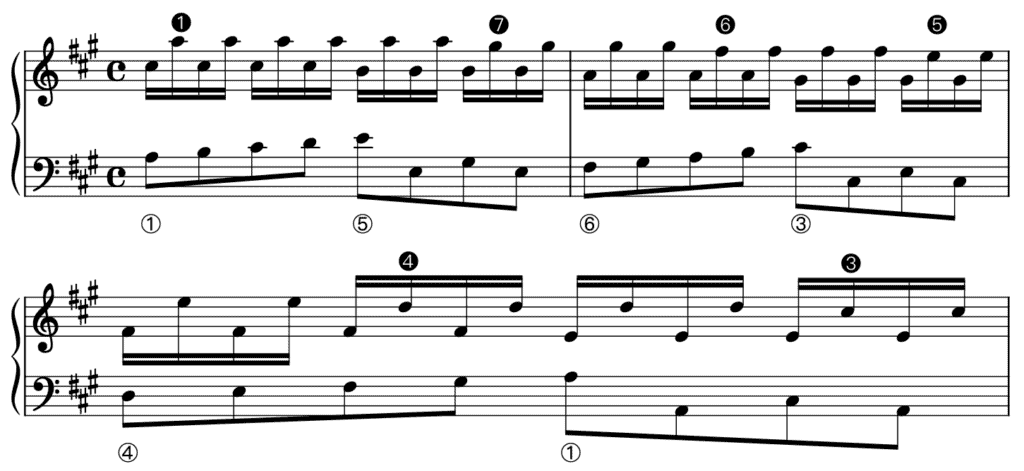
Interestingly, Durante was not bothered that the resolution of the 4–3 suspensions during the even stages (almost) coincides with the same note in the bass, that note being a consonant leap up a third. The reason for this is probably that that consonant leap up a third functions as an embellishment, not as a skeletal note.
Introducing New Harmonies
A harmonically interesting version of the Leaping Romanesca appears in Fenaroli’s counterpoint material. It uses a passing 6/+4 sonority during the second half of the uneven stages, causing the chord that follows to sound as establishing a new key. Contrary to the regular three-part settings of the Leaping Romanesca, the uneven stages in this version are set as complete triads, the even ones as incomplete triads (without fifth). Note that the melodic augmented second in the top voice during stage 3 was not considered to be a problem.

Q&A Moment
Shouldn’t the bottom note of the vertical tritones during the second half of the uneven stages resolve stepwise? While that voice leading would indeed be first choice, the bottom note can leap down a fourth in the context of a 6/+4 or 6/+4/( ♭)3 sonority. However, when the vertical sonority is 6/+4/2, the bass should descend a step.
The idea of tonicizing the even stages can be expanded to tonicizing every stage. To achieve this, the bass notes of the even stages are transformed into or become local leading notes.

Further Reading (Selection)
Primary Sources
Durante, Francesco. Partimenti numerati e diminuiti [e Fughe] (I-Nc 34-2-3).
Fenaroli, Fedele. METODO PER BENE ACCOMPAGNARE LIBRO 1, Partimenti, Critical edition, ed. Ewald Demeyere (Ottignies, 2021).
Fenaroli, Fedele. METODO PER BENE ACCOMPAGNARE LIBRO 1, Critical Comments, Critical edition, ed. Ewald Demeyere (Ottignies, 2021).
Fenaroli, Fedele. METODO PER BENE ACCOMPAGNARE LIBRO 2, Partimenti, Critical edition, ed. Ewald Demeyere (Ottignies, 2021).
Fenaroli, Fedele. METODO PER BENE ACCOMPAGNARE LIBRO 2, Critical Comments, Critical edition, ed. Ewald Demeyere (Ottignies, 2021).
Fenaroli, Fedele. METODO PER BENE ACCOMPAGNARE LIBRO 3, Partimenti, Critical edition, ed. Ewald Demeyere (Ottignies, 2021).
Fenaroli, Fedele. METODO PER BENE ACCOMPAGNARE LIBRO 3, Critical Comments, Critical edition, ed. Ewald Demeyere (Ottignies, 2021).
Fenaroli, Fedele. REGOLE MUSICALI PER I PRINCIPIANTI DI CEMBALO, A Comparative Edition (V1.0), compiled and edited by Ewald Demeyere (Ottignies, 2021).
Fenaroli, Fedele. The Parma Manuscript — Partimento Realizations of Fedele Fenaroli (1809), ed. Ewald Demeyere (Visby: Wessmans Musikförlag,2021).
Insanguine, Giacomo. Regole Con moti di Basso, Partimenti, e Fuge (I-Mc Noseda Th.c.116).
Mattei, Stanislao. Pratica d’Accompagnamento Sopra Bassi Numerati E Contrappunti A Più Voci (Bologna, 1824).
Secondary Sources
Gjerdingen, Robert O. Music in the Galant Style (New York: Oxford University Press, 2007).
Gjerdingen, Robert O. Child Composers in the Old Conservatories — How Orphans Became Elite Musicians (New York: Oxford University Press, 2020).
IJzerman, Job. Harmony, Counterpoint, Partimento: A New Method Inspired by Old Masters (New York: Oxford University Press, 2018).
Paraschivescu, Nicoleta. Die Partimenti Giovanni Paisiellos — Wege zu einem praxisbezogenen Verständnis (Basel: Schwabe Verlag, 2018).
Paraschivescu, Nicoleta (Translator: Chris Walton). The Partimenti of Giovanni Paisiellos — Pedagogy and Practice (New York: University of Rochester Press, 2022).
Sanguinetti, Giorgio. The Art of Partimento — History, Theory, and Practice (New York: Oxford University Press, 2012).
